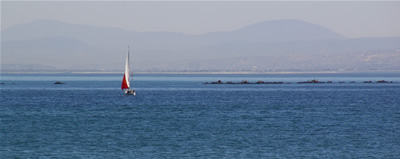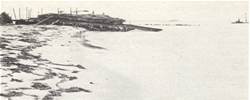|
||
|
|
Boater, Beware!San Diego’s Zuniga Jetty Will Gobble You Up
By Karen Scanlon Many a sailor have entered San Diego Bay some wary, others not, of a giant with bad teeth eager to gnaw on the bellies of boats. This giant is the decrepit, partially submerged Zuniga Jetty that reaches into the bay nearly a mile and a half from the channel-bordering edge of North Island. “It’s only dangerous if you run into it,” says Capt. Kenneth Franke, USCG (Ret.) and independent contractor for the Coast Guard as instructor in marine wood and composite vessels. “The jetty is a repository for a lot of property, rudders, and a few keels.” Franke advises against wandering around the bay without charts. “People run aground because they just don’t pay attention. “They’ll come down from the north, and overshoot the jetty then try to get back in line with the range lights and back into San Diego Bay. They don’t realize they’re on the east side of the jetty, and cut across scraping the bottoms of their boats.” According to David Johnson, Public Affairs, California Department of Boating and Waterways, four boating accidents occurred in 2006 that were attributed to the area of Zuniga Jetty. “But we get only the reported incidents,” Johnson says, “and these things are likely under reported.” A full-on grounding took place earlier this year. The trouble along this waterway began not in our lifetimes but when shoals flanked the channel and entrance to San Diego Bay. One such hazard was the mile-long Zuniga Shoal that extended north and south on the east side of the channel entrance. It was not uncommon for ships to be grounded here, including the luxury steamship Golden Gate in 1854,which caused considerable embarrassment for city planners. Old sailing directions described precisely the tedious route that had to be taken to avoid Zuniga Shoal, with its natural deposition of silt from the San Diego River. (Please see sidebar.) In 1853, the Army Corps of Engineers constructed a dike, hoping to divert the river’s flow into what was called False Bay (today, we know it as Mission Bay). Within two years, the dike failed. Congress appropriated more funds, and a long levee was completed 25 years later. This time, the intended diversion held. A survey of the harbor entrance was undertaken by the Corps in 1890 for the construction of a jetty of brush and stone, and for the dredging of Zuniga Shoal. A double track, standard-gauge railroad was laid over a wooden trestle for deploying rock. More tracks were laid as rock was deposited. Rocks used to build up the jetty were quarried in San Diego’s East County. By 1894, the 3,335-foot Zuniga Jetty was completed to restrain the movement of coarse sand through intertidal zones along Coronado. It would also increase the strength of tidal currents to produce a scouring effect upon the outer bar and deepened channel. In its early years, the jetty was strengthened and lengthened several times to its present 7,500 feet. But today, the crux of the matter is that the giant needs an implant. Scan the length of the breakwater and you’ll notice its broken and missing “teeth.” What you won’t see, depending upon the changing tides, is what lies just beneath the surface of the water — the submerged portions of the decaying jetty. Greg Fuderer, spokesman for the Army Corps of Engineers Los Angeles District, says that the Corps has always been responsible for Zuniga Jetty, and still is. “We would like to be able to do some work on the jetty, but it is dependent upon funding, and it takes, literally, an Act of Congress, and we simply don’t have it,” Fuderer says. So if you’re out cruising on beautiful San Diego Bay, sailor, take note (and charts). SIDE BAR “Steer right through the kelp, giving Pt. Loma a berth of one-half mile and in a few minutes you will open up Ballast Point, a low beach of single stones, forming a natural breakwater. Then round up gradually until you bring Ballast Point in range with the easternmost house on the Playa and be very careful not to open up more of the village, otherwise you will be too far to the east and in danger of getting aground on Zuniga Shoal…”
|
|
 April
2007
April
2007
 Building mat for end of extension of shore revetment, San Diego jetty (Zuniga). September 1895.
Building mat for end of extension of shore revetment, San Diego jetty (Zuniga). September 1895. San Diego jetty, from end of old work, Bent 158, showing spur and breaker to west of line of jetty, October, 1895.
San Diego jetty, from end of old work, Bent 158, showing spur and breaker to west of line of jetty, October, 1895.